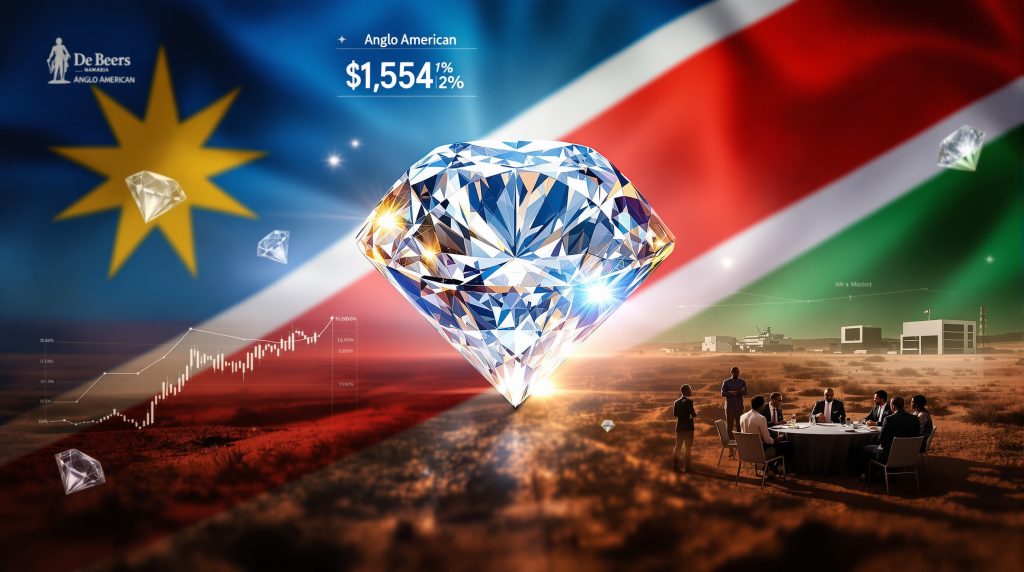Namibia's Cautious Approach to De Beers Stake Acquisition
Namibia's government is taking a measured stance toward potentially acquiring a stake in global diamond giant De Beers, as industry evolution trends prompt careful consideration of the long-term value proposition. The country's existing diamond operations, primarily through a joint venture with De Beers, represent a crucial economic sector that demands strategic planning amid evolving market dynamics.
What Is the Current Relationship Between Namibia and De Beers?
Namibia maintains a significant diamond partnership with De Beers through their 50-50 joint venture, Namdeb Holdings. This arrangement has positioned Namibia as an important player in De Beers' production network, contributing approximately 2.2 million carats of rough diamonds in 2024—representing about 9% of De Beers' total global output.
The partnership extends beyond mere production figures. Established over decades, this collaboration has evolved into a cornerstone of Namibia's mining sector and broader economy, with diamond mining contributing 8-10% to the country's GDP while providing substantial employment opportunities and tax revenue.
Namibia also operates Namdia, a state-owned entity that purchases 15% of Namdeb's production by value, allowing the country to independently market and sell a portion of its diamond resources on the international market. This arrangement gives Namibia some autonomy within the broader partnership framework.
Why Is Namibia Hesitant About Acquiring a De Beers Stake?
Diamond Industry Challenges
Namibia's Deputy Prime Minister Natangwe Ithete has expressed significant caution regarding potential investment in De Beers, citing several industry-wide challenges:
- Increasing market pressure from laboratory-grown diamonds
- Weakening global demand for natural diamonds
- Overall downward trajectory of the diamond industry
"The diamond industry is going down. It is not a secret that the industry is under pressure and affected by synthetic diamonds," Ithete noted in recent statements to financial media, emphasizing the need to "study very carefully" whether pursuing a stake would deliver sufficient value.
Laboratory-grown diamonds have emerged as a disruptive force in the traditional diamond market. These stones typically sell for 30-40% less than comparable natural diamonds while offering similar aesthetic qualities, making them increasingly attractive to price-conscious consumers.
Economic Considerations
The diamond sector's current volatility presents several economic concerns for Namibia:
| Factor | Impact on Stake Decision |
|---|---|
| Synthetic diamond competition | Eroding natural diamond market share and pricing |
| Global demand fluctuations | Creating uncertainty in revenue projections |
| De Beers valuation concerns | Potential overvaluation amid industry downturn |
| Return on investment uncertainty | Questionable long-term value proposition |
Anglo American currently values De Beers at approximately $4.9 billion, though this figure comes after recording $3.5 billion in impairments over the past two years. Market analysts suggest that current industry pressures may result in acquisition offers below this valuation.
For Namibia, these factors combine to create a complex risk assessment. The country must balance the potential strategic benefits of increased ownership against the financial risks of investing in a sector facing structural challenges.
How Does the De Beers Sale Fit Into Anglo American's Strategy?
Anglo American's Portfolio Restructuring
Anglo American's decision to divest De Beers represents a strategic pivot toward:
- Focusing on copper and iron ore assets
- Pursuing a merger with Canada's Teck Resources
- Creating a more concentrated portfolio of high-demand metals
- Reducing exposure to the volatile diamond market
The September 9th announcement of Anglo American's pursuit of a merger with Teck Resources signals the company's intent to establish itself as a major player in the copper sector—a metal essential to the global energy transition.
This strategic shift reflects broader mining consolidation insights where mining conglomerates are repositioning their portfolios toward metals that support renewable energy technologies and electric vehicle production. Copper, with its essential role in electrification, offers potentially stronger long-term growth prospects than diamonds.
Valuation and Impairment Challenges
The $3.5 billion in impairments that Anglo American has recorded against De Beers over the past two years reveals the challenging market conditions facing the diamond industry. These write-downs reflect both current market weakness and concerns about the sector's long-term trajectory.
The timing of Anglo American's divestment decision also suggests an assessment that diamond industry headwinds may persist, making this an opportune moment to exit the sector and redeploy capital toward growth areas like copper.
Who Else Is Interested in Acquiring De Beers?
Pan-African Consortium Potential
Several African nations have expressed interest in acquiring stakes in De Beers:
-
Angola: Endiama, Angola's state diamond company, formally announced a bid for a minority stake on September 24th
-
Botswana: Currently holds a 15% stake in De Beers and is pursuing a controlling interest
-
South Africa: Has been mentioned as a potential consortium member
Angola has advocated for a broad ownership structure that would include all major African diamond-producing countries where De Beers operates, creating a pan-African ownership model.
This consortium approach could potentially create a unified African voice within the global diamond industry, allowing producing countries to exercise greater influence over pricing, marketing, and strategic decisions affecting their natural resources.
Competitive Landscape
By June, De Beers had attracted interest from at least six prospective investors, creating a competitive bidding environment. This diverse interest suggests that despite industry challenges, strategic investors still see long-term value in De Beers' extensive mining operations, distribution networks, and brand recognition.
The competition for De Beers ownership stakes introduces an additional consideration for Namibia—waiting too long could mean missing the opportunity entirely if other bidders move more quickly.
What Are the Strategic Implications for Namibia's Diamond Industry?
Benefits of Potential Stake Acquisition
Should Namibia eventually decide to pursue a stake in De Beers, several potential benefits could emerge:
- Greater influence over global diamond pricing and marketing strategies
- Enhanced access to downstream value chain opportunities
- Stronger coordination with other African diamond producers
- Increased revenue potential beyond current joint venture arrangements
Taking a direct ownership position could allow Namibia to participate in decisions about synthetic diamond strategies, retail operations, and technological innovations—areas that extend beyond its current production-focused partnership.
Risks of Maintaining Current Position
Conversely, remaining solely as a joint venture partner could present challenges:
- Limited influence over De Beers' broader strategic decisions
- Vulnerability to new ownership priorities and objectives
- Reduced ability to shape industry responses to synthetic diamond competition
- Potential marginalization if other African nations increase their ownership stakes
If Botswana succeeds in acquiring a controlling interest in De Beers while Namibia remains only a production partner, the power dynamic could shift, potentially affecting Namibia's negotiating position in future joint venture discussions.
How Might the Changing Diamond Market Affect Future Decisions?
Synthetic Diamond Disruption
The rise of laboratory-grown diamonds represents a fundamental disruption to the natural diamond industry:
-
Price advantages of synthetic diamonds (typically 30-40% lower than natural equivalents)
-
Improving quality and consumer acceptance of lab-grown stones
-
Ethical and environmental marketing advantages for synthetic producers
-
Technological advances continuously reducing production costs
The synthetic diamond market has grown at double-digit rates in recent years, capturing an increasing share of the overall diamond jewelry market. This trend shows no signs of reversing, with technology improvements continuously enhancing the quality while reducing the cost of laboratory-grown stones.
Consumer Demand Shifts
Changing consumer preferences are reshaping the diamond market:
-
Younger generations showing less attachment to traditional diamond symbolism
-
Increasing interest in ethical sourcing and environmental impact
-
Growing acceptance of alternative gemstones and synthetic options
-
Price sensitivity amid global economic uncertainties
Millennial and Gen Z consumers, in particular, have demonstrated different purchasing patterns compared to previous generations, with greater emphasis on sustainability, ethical considerations, and value—all factors that can work against traditional natural diamond marketing.
What Timeline Can Be Expected for Namibia's Decision?
While no specific timeline has been announced for Namibia's decision, several factors will likely influence the process:
- Completion of comprehensive market and valuation studies
- Consultation with regional partners, particularly Botswana and Angola
- Assessment of financing options and investment structures
- Analysis of De Beers' strategic plans under new ownership
Given the complexity of these considerations and Deputy Prime Minister Ithete's emphasis on careful study, a measured decision-making process seems likely.
The timeline may also be influenced by developments in the broader bidding process, including any deadlines set by Anglo American or competitive moves by other potential investors. Should a pan-African consortium approach gain momentum, Namibia may need to accelerate its decision-making process to secure a position within the consortium.
FAQ: Namibia's Potential Stake in De Beers
How much of Namibia's economy depends on diamond mining?
Diamond mining contributes approximately 8-10% of Namibia's GDP and represents one of the country's largest export sectors. The industry also provides significant employment opportunities and tax revenue.
Would a stake in De Beers give Namibia more control over its diamond resources?
A direct stake in De Beers could potentially provide Namibia with greater influence over broader corporate strategy and marketing, though the existing 50-50 joint venture already gives the country significant control over local diamond operations.
How might Anglo American's restructuring affect Namibia's diamond industry?
Any change in De Beers ownership could potentially impact operational priorities, investment decisions, and marketing strategies, all of which could affect Namibia mining updates. This uncertainty is likely contributing to the country's cautious approach.
What alternatives might Namibia consider instead of a direct stake?
Rather than pursuing a direct stake, Namibia could potentially negotiate enhanced terms in its existing joint venture agreement, expand its downstream diamond processing capabilities, or develop alternative marketing channels for its diamonds.
Industry Outlook and Considerations
The diamond industry stands at a crossroads, with traditional market structures facing unprecedented challenges from new technologies and changing consumer preferences. For diamond-producing countries like Namibia, these developments necessitate thoughtful strategic planning.
While laboratory-grown diamonds present a significant challenge to natural diamond producers, the luxury segment of the market has shown more resilience. De Beers' brand strength and marketing capabilities could potentially help differentiate natural diamonds as premium products in this evolving marketplace.
For Namibia, the decision about De Beers ownership involves balancing immediate financial considerations against long-term strategic positioning in a transforming industry. The country's cautious approach reflects this complex assessment, prioritizing thorough analysis over rushed corporate takeover strategies.
As Angola's state diamond company Endiama and Botswana pursue their own stakes in De Beers, the potential for a coordinated African approach to diamond industry leadership offers an intriguing possibility—one that could reshape global diamond markets while strengthening the position of producing countries in the value chain.
For those considering the broader financial implications, carefully reviewing investing guide insights can provide perspective on how such industry transformations might impact investment portfolios in the natural resources sector.
Want to Spot the Next Major ASX Mineral Discovery?
Discovery Alert's proprietary Discovery IQ model provides instant notifications when significant mineral discoveries are announced on the ASX, giving investors a crucial edge before the market reacts. Explore how historic discoveries have generated substantial returns by visiting the Discovery Alert discoveries page and start your 30-day free trial today.




